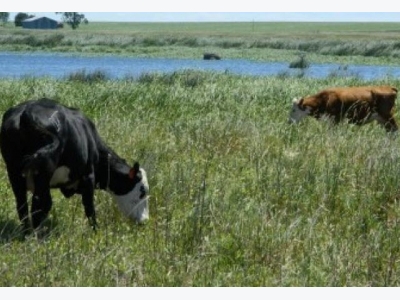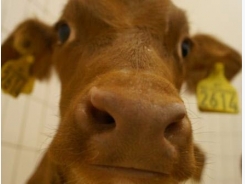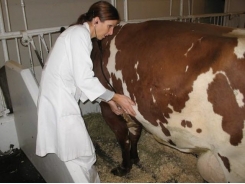Grazing reed canarygrass may control invasive plant

Cattle graze on reed canarygrass, an aggressive pest plant in Nebraska’s Rainwater Basin. Grazing could keep the invasive species in check and provide economic return to cattle farmers. Photo - Credit: John Guretzky
Wetland invader could be forage for cattle.
The Rainwater Basin of southeastern Nebraska provides a vital resting stop and feeding station for tens of millions of migratory waterfowl every year. There, the native wetland plants produce enough seed to replenish the birds some of them threatened or endangered species for their long journey, according to an announcement from the American Society of Agronomy.
However, a non-native grass species has been inflicting damage in wetlands all over the U.S. Reed canarygrass displaces native, high-seed-producing species by forming dense stands and clogging patches of open water in the wetland, the announcement said. It can survive through cold winters and tolerates both drought and moist conditions.
“It’s aggressive; nothing stops its growth,” said John Guretzky, a University of Nebraska-Lincoln grassland systems ecologist who has been studying an innovative way to contain the reed canarygrass’s destruction of seed-producing plants in wetlands.
Guretzky hopes to make the prospect of keeping wetlands in place more attractive through his experiment that tests the usefulness of wetlands invaded by reed canarygrass as a feed source for cows.
By grazing or haying the wetlands, producers could access a free feed source for their cattle. The cattle would disturb the reed canarygrass enough to create open spaces for other vegetation, and then more open waters would be available for foraging water birds.
“We’re trying to encourage producers to graze or harvest the wetlands,” he explained. “That way, producers could still get value through the land.”
Guretzky wanted to know how repeated forage harvests would affect reed canarygrass. He also wanted to know how productive and nutritious the harvested wetlands were.
Guretzky simulated repeated grazing events on two wetlands in Seward County, Neb. During the dry, summer season, he and his research team “grazed” (mowed) wetland plots between zero and three times. They found that the wetlands produce enough fodder to satisfy cattle nutrient needs.
They also found that the more plots are grazed, the more likely other species besides reed canarygrass will have a chance to thrive.
“Removing all that top growth lets more light in on the soil,” he said. Reed canarygrass stems and leaves tend to smother annual plants and block the sunlight. By repeatedly mowing, the team gave other plants a chance to grow.
However, reed canarygrass proved more stubborn than Guretzky thought. Over the three-year experiment, the team made a slight dent in the reed canarygrass’ hold in only one of the locations.
“If you don’t maintain that grazing pressure, you won’t see a strong decline in the reed canarygrass,” he said. “We didn’t have quite the impact we expected to.”
Guretzky said the next step would be to bring cows into the wetlands and let them graze repeatedly during the growing season. A longer experiment, with consistent grazing pressure, might loosen reed canarygrass’ stronghold enough to let other species in. Guretzky said there’s probably no way to fully eradicate it without using herbicides and cutting the root structure with sharp disks.
Related news
Tools

Phối trộn thức ăn chăn nuôi

Pha dung dịch thủy canh

Định mức cho tôm ăn

Phối trộn phân bón NPK

Xác định tỷ lệ tôm sống

Chuyển đổi đơn vị phân bón

Xác định công suất sục khí

Chuyển đổi đơn vị tôm

Tính diện tích nhà kính

Tính thể tích ao



 New urine sensors to track cows' nitrogen excretion
New urine sensors to track cows' nitrogen excretion  We carry viruses from barn to barn
We carry viruses from barn to barn